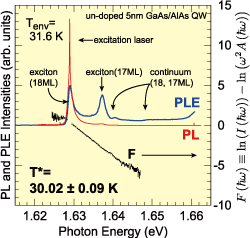Thermal-Equilibrium Relation in Optical Spectra of Semiconductor Quantum Well
Akiyama Group
Kennard-Stepanov (KS) relation is a fundamental thermal-equilibrium relation between optical spectra of emission (I) and absorption (A) [1,2]. Using this relation for photoluminescence (PL) and PL-excitation (PLE) spectra, we have investigated the energy distribution of carriers in doped [1] and un-doped semiconductor quantum wells (QW) fabricated by molecular beam epitaxy. Through improving sample homogeneity as well as S/N ratio of measured spectra, we revealed that temperature T* deduced from optical spectra shows agreement (deviation) with environment lattice temperature Tenv under resonant (non-resonant) excitation condition, which indicates the formation of quasi- (non-) equilibrium carrier distribution in both doped and un-doped QWs.

Fig.1. PL (red curves) and PLE (blue curves) spectra from an un-doped 5 nm GaAs/AlAs QW. PL spectra are obtained under resonant excitation.
Black dots with error bars indicate the value of function F deduced from PL and PLE spectra.
Temperature T* = 30.02 K, which are calculated from the slope of function F, shows excellent agreement with environment temperature Tenv = 31.6 K measured with a Si diode thermometer.
PL and PLE spectra of an un-doped 5 nm GaAs/AlAs single QW at Tenv = 31.6 K are shown in Fig. 1. The red and blue curves indicate PL and PLE spectra, respectively. High homogeneity of the QW is reflected in exciton peaks with both narrow linewidth (1.4 meV) and clearly splitted lineshape due to well width difference by a monolayer (ML). Black dots with error bars in Fig. 1 show the value of function F, which can be calculated only from measured PL and PLE spectra (see the right axis label of Fig. 1 for definition of F). Temperature T* deduced from the slope of function F on the basis of KS relation shows excellent agreement with Tenv, as was observed in doped QW in the range of 5 - 220 K [1]. This demonstrates the realization of quasi-equilibrium distribution even in an un-doped system, where the heat capacitance of carriers is considered to be quite smaller because of the absence of doped carriers.
References
- T. Ihara et al., Phys. Rev. B 80, 033307 (2009).
- E. H. Kennard, Phys. Rev. 11, 29 (1918); B. I. Stepanov, Sov. Phys. Dokl. 2, 81 (1957).
